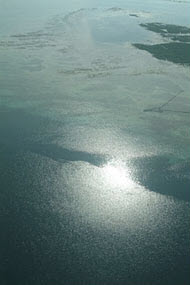
Deep Ocean Circulation
Salinity and Deep Ocean Currents Scientific Investigation

![]() Before you begin the scientific investigation below, make sure to download the Salinity and Deep Ocean Currents Scientific Investigation Report. As you complete this scientific investigation, fill in any needed information on the report template. If you need more information about each section of the report, please visit the Developmental Module.
Before you begin the scientific investigation below, make sure to download the Salinity and Deep Ocean Currents Scientific Investigation Report. As you complete this scientific investigation, fill in any needed information on the report template. If you need more information about each section of the report, please visit the Developmental Module.
This scientific investigation is available below or in a printable version.
Introduction
Ocean currents are formed many ways. For example, wind moves the water along the surface to form wind-driven currents or surface currents. Deep ocean currents are caused by differences in water temperature and salinity.
Objectives
In this scientific investigation, you will:
- explore the relationship between salinity and density in deep water currents.
Hypothesis
Using the Procedure and Data Collection section below, read through the procedural information for this scientific investigation. Based on your understanding of the procedure, develop your own hypotheses which describe your expected results. Record your hypotheses in the Hypothesis section of your Salinity and Deep Ocean Currents Scientific Investigation Report.
Equipment and Materials
- 4 small jars (like baby food jars)
- 2 index cards or card stock
- Table salt
- 2 colors of food coloring
- Towels
Procedure and Data Collection
WARNING: It is recommended that you conduct this scientific investigation in an area where water spills will not cause damage. In addition, you should not conduct this experiment near any electrical devices.
 Fill both baby food jars with water. Dissolve the salt in one of the jars and add a drop of blue food coloring. Make sure to mark the jar "Salt Water." Add a drop of red food coloring to the other jar and label it "Fresh Water."
Fill both baby food jars with water. Dissolve the salt in one of the jars and add a drop of blue food coloring. Make sure to mark the jar "Salt Water." Add a drop of red food coloring to the other jar and label it "Fresh Water."- Place one of your index cards or pieces of card stock on top of the salt water jar to cover the opening, and carefully keep your hand over the card and the jar as you turn the jar over.
- Place the saltwater jar on top of the fresh water container and carefully remove the card while the two jars are on top of each other in order to uncover the opening to the jar with the blue water or "salt" water. In the Data section of your Salinity and Deep Ocean Currents Scientific Investigation Report, observe and make notes of the results.
- Use the second set of jars to repeat the experiment. This time, cover the opening to the red-water or fresh-water jar with the other index card or card stock, carefully keep your hand over the card as you turn the entire jar over and place it on top of the saltwater jar. Remove the card to uncover the opening. In the Data section of your Salinity and Deep Ocean Currents Scientific Investigation Report, observe and make notes of the results.
- Take each set of jars and turn it horizontally by holding the salt-water jar in one hand and the fresh-water jar in the other and apply horizontal pressure to keep the openings in line. In the Data section of your Salinity and Deep Ocean Currents Scientific Investigation Report, observe and make notes of the results.
Data
Use the spaces provided in the Data section of your Salinity and Deep Ocean Currents Scientific Investigation Report to record your data from this scientific investigation.
Data Analysis
In the Data Analysis section of your Salinity and Deep Ocean Currents Scientific Investigation Report, provide responses to the following questions. Make sure to completely answer each question.
- Is salt water heavier or lighter (higher or lower in density) than fresh water? Make sure that you explain your answer in terms of the results that you obtained from your experiment.
- If evaporation causes surface water to be salty, where would you expect ocean water to be very dense?
- Does this correspond to where deep ocean currents originate?
- Does the density of ocean water have any relationship to the temperature of ocean water?
Conclusion
Using the Conclusion section of your Salinity and Deep Ocean Currents Scientific Investigation Report, compose three to four sentences describing an overall conclusion about the relationship between salinity, density, and deep ocean currents. Were your hypotheses true or false, and how do you know? Use the data and notes that you collected from your simulation experience to form your conclusion. Make sure that you include information that you gained from data analysis to support your conclusion.
Experimental Sources of Error
On your Salinity and Deep Ocean Currents Scientific Investigation Report, provide responses to the following questions: Are there any sources of error? If so, what are they, and what could be done to minimize error?
![]() Once you have completed the Salinity and Deep Ocean Currents Scientific Investigation Report, please submit your work to the dropbox.
Once you have completed the Salinity and Deep Ocean Currents Scientific Investigation Report, please submit your work to the dropbox.



